Advent is the first period of the christian liturgical calendar, the first period of the Liturgical Year. Advent begins the Sunday nearest November 30, the day of Saint Andrew the Apostle. The season of Advent ends on the 24th, the day of christmas Eve.
Advent is a time of preparation, joy and penance. The colors used during the liturgical celebrations are the purple and the pink.
There are four days that are especially important during the time of Advent: the four Sundays of Advent. In these days so relevant we use an Advent calendar as a guide and the candles and the Advent wreath as a focal point for prayer and meditation.
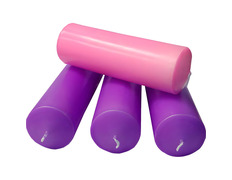
Ref: 3B0302C
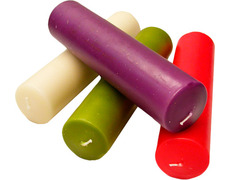
Ref: 3B304C
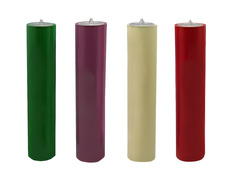
Ref: 4B24025094C
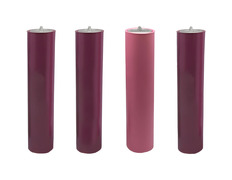
Ref: 4B24025092C
The Advent candles are, along with the Advent wreath, one of the most important elements during the time of Advent. The Advent candles are usually four and are placed in the Advent wreath. A candle is lit for each Sunday of Advent. At the end of the season of Advent, the fourth Sunday of Advent, the four candles shall remain lit.
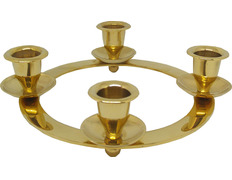
Ref: 94F10010

Ref: 3F61A

Ref: 1B036

Ref: 1F8863
The Advent wreath, along with the candles of Advent, a very important element within the celebration of the Advent season. The advent wreath is usually formed by two parts: a structure in which are located the candles of Advent, and a central part for the decorations.
The time of Advent is a period of the Liturgical Year during which we prepare for the birth of Jesus to Christmas. During Advent we should try to reach goals that prepare our body and our soul to Jesus. Within these objectives that bring us closer to Jesus includes praying, doing penance for the sins committed throughout the year, dedication to others, reconciliation and rapprochement, etc...
The Advent calendar is a tool that serves us as a guide to achieve the objectives. The Advent calendar allows us to fragment the overall goals into concrete daily activities. In this way, with the Advent calendar, we can plan our day-to-day, and, in this way, not to forget any of the goals.

Ref: 52B506RS

Ref: 52F529

Ref: 52F510

Ref: 84F114

Ref: 52R543

Ref: 52F535

Ref: 52F522

Ref: 52R586

Ref: 84F006

Ref: 52F506

Ref: 84F075

Ref: 84F062
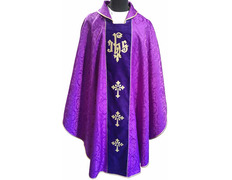
Ref: 84F049

Ref: 52R543

Ref: 4T20110
The chasubles are one of the garments liturgical most important of which employ priests. The priests at the time of the Eucharist, choose one color or another of chasuble in function of the period of the Liturgical Year in which it is located. The Advent season is characterized by joy and by penance. For this reason, the liturgical colors associated with the season of Advent are purple and pink.

Ref: 84FK01

Ref: 84FK01

Ref: 1F4004

Ref: 1F84023
The colors of the cloths lectern, or covers both, also are determined by the period of the Liturgical Year that we live. During the time of Advent, the panels of the lectern are usually purple or pink in color.

Ref: 3F7120

Ref: 3F5036

Ref: 3F7119
The banners for Advent are tarps or exhibitors that are usually placed on the altar to give color. The banners of the altar are usually purple, the liturgical color that permeates the greater part of the time of Advent.
Advent is the first period of the liturgical calendar, christian. To find the true meaning of Advent we go back several centuries ago. The word advent comes from the Latin word "adventus" meaning “coming”. That is to say, that the meaning of Advent is content in itself, Advent literally means the coming of Jesus.
The Advent has a meaning determined by the coming of Jesus, the Birth of Jesus by Christmas. Only you can understand the Advent linked with the Christmas. Advent is the period of preparation for Christmas. The children of God we must prepare our body and our soul for the “coming” of our Savior.
In this process of preparation is very important to the color purple, the liturgical color associated with the Advent. Purple means penance. During advent we need to look within us and seek our sins to repent of them, and free our hearts of this burden. Through penance we get closer to Jesus.
The time of Advent is the first period of the Liturgical Year. The season of Advent begins the first Sunday of Advent and ends on the day of christmas Eve. During Advent we prepare for the coming of Jesus, for this reason, the last of Advent is always the same, on the 24th of December, the day of Birth of Jesus.
In change, the date of the first day of advent, the first Sunday of Advent varies from year to year. The first Sunday of Advent is the Sunday nearest to the day 30 of November, a day which the Church celebrates the day of St. Andrew the Apostle. That is to say, the first Sunday of Advent can be from the 27 November to 03 December.
For this reason, the time of Advent varies. In the years in which the season of Advent has a longer duration to be lengthened to 28 days, while the years that Advent has a lower duration is 22 days. In the latter case, the time of Advent, more briefly, on the fourth Sunday of Advent coincides with the Eve.
In the time of Advent is always going to have four Sundays of Advent, but, depending on the year, may not be held on the fourth Saturday of Advent, the fourth Friday of Advent, on the fourth Thursday of Advent, etc...
Prayers is one of the most important elements in any period of the Liturgical Year. During Advent, in the process of preparation for the coming of Jesus, we must be sensitive to the prayers.
While we pray our prayers of Advent, we draw close to Jesus, talk with Him, so intimate and personal. The prayers are our time alone with Jesus.
To pray the prayers of Advent it is important to take consciousness of the importance of the moment. The prayers of Advent must be accompanied by a deep meditation. We must look back and search our inner. Banish the hypocrisy of our mind and to be rigorous in the analysis of ourselves. This is the only way to pray the prayers of Advent sincere.
There are a lot of prayers of Advent. Most of the prayers are addressed to the Child Jesus. The time of Advent is intimately linked with the Birth of Jesus.
I beg you, Lord, that you would send, whom you send, Come, Lord Jesus, and not the afternoon; skies open up and let drop their dew. Divine Child Jesus, come to birth in my heart to banish him to the sin, and put your virtues.
Amen.
Collection of Advent prayer of José Gálvez Krüger
The time of Advent, a Time of waiting.
God is about, God that is just now arriving.
Hope of the people, the new life.
The Kingdom is born, a gift and a task.
We sing a good Father to hope.
With Mary, help us,Lord,
to live generously in the delivery,
to offer our lives as she,
to listen to your Word at all times,
to practice without the rest of the Gospel,
help us to live in solidarity with those who suffer,
with those who today as yesterday in Bethlehem did not take place. We sing a Good Father to hope.
With the shepherds of Bethlehem,
help us lord to live the Vigil of thy Kingdom,
to run haste to your encounter,
to discover your Face in the middle of the village,
to not stay "asleep" in the construction of the new world. We sing a Good Father to hope.
With the angels of Bethlehem,
help us, Lord,
to sing to the world your Presence,
God-is-with-us !
Let us build peace among men,
Let's build the Justice between peoples. We sing a Good Father to hope.
With Jesus as a child-God, help us,Lord,
to entertain the hope that is born in each Advent,
to hear the cries of your people,
watering with our lives the seed of your Kingdom,
to be Messengers of your Love,
building communities of service and prayer. Christmas, the feast of the man.
Christmas, the feast of God.
We want to be your Witnesses,
give us the strength Lord.
Advent prayer of Marcelo A. Murúa, of the book "See life with the eyes of the Gospel"
The Advent candles are, along with the Advent wreath, one of the most important elements during the time of Advent. The Advent candles are usually four and are placed in the Advent wreath. A candle is lit for each Sunday of Advent. At the end of the season of Advent, the fourth Sunday of Advent, the four candles shall remain lit.
The Advent candles are usually of wax, to be more traditional, and have the four liturgical colors: sail red, a candle color purple, a candle color green, and a candle white. Also very popular are the games of sails of two colors, a candle of Advent to pink in color, to turn on the third Sunday of Advent (Gaudete), and three Advent candles purple color, to turn on the first, second and fourth Sunday of Advent.
The size of the Advent candles varies, depending on the size of the Advent wreath. It is usual that the candles have to be a little thick, between 3 and 6 cm in diameter.
The Advent wreath, along with the candles of Advent, a very important element within the celebration of the Advent season.
The advent wreath is usually formed by two parts: a structure in which are located the candles of Advent, and a central part for the decorations.
The structure where to put the candles can be of many shapes and materials. It is usual that the Advent wreaths have a circular shape. This form of circumference indicates to us the infinite love of Jesus for us. There are also Advent wreaths, rectangular, square, etc... you Always have to take into account a place where you are going to locate the crown.
The central part of the Advent wreath, including the candles of Advent, usually is decorated with some kind of green vegetation. These ornaments color green represents hope and joy. The proximity of the Birth of Jesus is an occasion of hope and joy. The Child Jesus, with his birth, gives us a new opportunity.
The central part of some Advent wreaths include a fifth candlestick to incorporate a fifth candle of Advent.
The time of Advent is a period of the Liturgical Year during which we prepare for the birth of Jesus to Christmas. During Advent we should try to reach goals that prepare our body and our soul to Jesus. Within these objectives that bring us closer to Jesus includes praying, doing penance for the sins committed throughout the year, dedication to others, reconciliation and rapprochement, etc...
The Advent calendar is a tool that serves us as a guide to achieve the objectives. The Advent calendar allows us to fragment the overall goals into concrete daily activities. In this way, with the Advent calendar, we can plan our day-to-day, and, in this way, not to forget any of the goals.
There is a wide variety of Advent calendars, Advent calendars to color, Advent calendars to hang, Advent calendars for table, etc... Each of them has its own characteristics. Most of them are divided into days. In such a way that in the Advent calendars in each day we have a recommendation to carry out an action that prepares us for the Birth of Jesus.
Each Advent calendar structure recommendations in a particular way. The important thing to choosing an Advent calendar is to have regard to the range of objectives that mark. That is to say, by carrying out the recommendations that I proposed to the calendar I am most close to Jesus? I feel closer to Jesus?
It is very important to adapt the recommendations to our particular situation. The recommendations are generic and may mark broad objectives. You should adapt these goals to our life and circumstances. Maybe I don't have the ability to make major changes in my environment, but if I can improve certain things in my life and the lives of the people around me. Any progress is well received, any improvement in our internal or in our environment brings us closer to Jesus.
The season of Advent begins the first Sunday of Advent, the date we celebrate the Sunday nearest to 30 November, the day of St. Andrew the Apostle. This circumstance causes that the duration of the season vary. The Advent calendar can start from 27 November to 03 December. Changes in the date of the first Sunday of Advent cause Advent calendars only can be used one year. The Advent calendar that we use this year will not be appropriate for the next year because the date of the first Sunday of Advent will be different.
In Religious Articles Brabander we have designed an Advent calendar universal, that serves to any year, independent of when it is the first Sunday of Advent. We hope it can be of interest to you.
The chasubles are one of the garments liturgical most important of which employ priests. The priests at the time of the Eucharist, choose one color or another of chasuble in function of the period of the Liturgical Year in which it is located. The Advent season is characterized by joy and by penance. For this reason, the liturgical colors associated with the season of Advent are purple and pink.
The chasubles, and other ornaments, of purple are used in the celebrations of the first Sunday of Advent, the second Sunday of Advent and the fourth Sunday of Advent. The chasubles purple of Advent remind us that to be prepared for the Birth of Jesus, we must analyze the sins you have committed and repent.
The chasubles roses us a symbol of joy, a symbol of hope for the Birth of Jesus. The priests wearing chasubles rose during the third Sunday of Advent, Gaudete. During these celebrations the joy of the proximity of Christmas envelops the Eucharist.
The colors of the panels of the lectern, or covers both, also are determined by the period of the Liturgical Year that we live. During the time of Advent, the panels of the lectern are usually purple or pink in color.
The covers both are a piece used to beautify the altar. Are often embroidered with motifs of the liturgical or eucharistic as JHS, the ears of corn, grapes, etc... The dimensions of a cloth lectern can vary to adapt to the stands or both.
The colours for Advent are tarps or exhibitors that are usually placed on the altar to give color. The banners of the altar are usually purple, the liturgical color that permeates the greater part of the time of Advent.
The colours of Advent are decorated with elements typical of the first period of the Liturgical Year: Advent candles, Advent wreaths, etc...